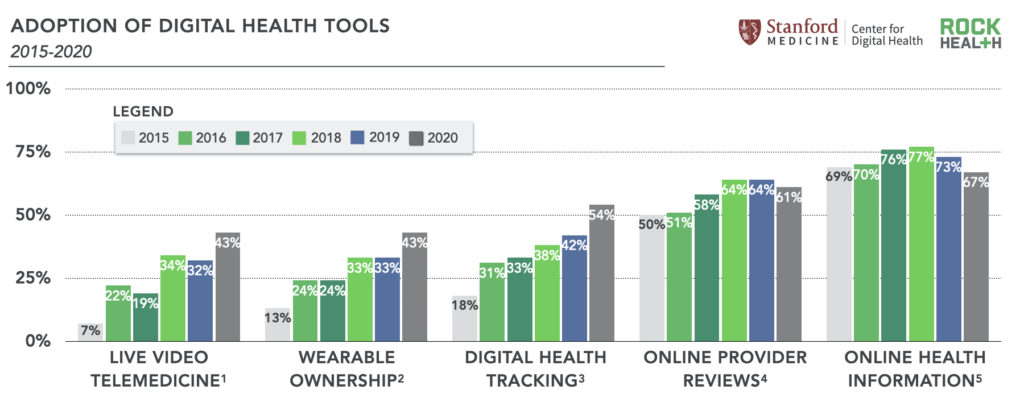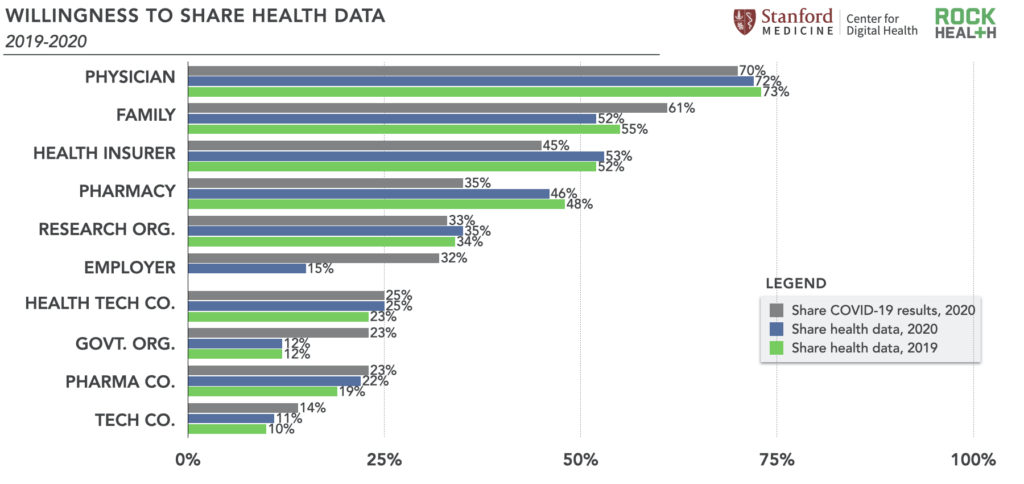Digital Health Consumer Adoption Report 2020
We are grateful to the Stanford Center for Digital Health team for their collaboration and support in writing this report, with special appreciation to Clark Seninger, MBA, Natasha Din, MD, Krishna Pundi, MD, Alex Perino, MD, and Mintu Turakhia, MD.
Since 2015, Rock Health has annually surveyed 4,000 consumers to understand consumer adoption of digital health technologies. Over the five years prior to 2020, adoption has steadily climbed. Then came 2020, along with a global pandemic. For the first time, digital health solutions were not simply an enhancement, but rather a necessity in healthcare access and delivery. To better understand the implications of the pandemic on consumer behavior and preferences, we doubled our survey sample size. Below, we’ve outlined select findings and invite you to read the full report.
In many ways, COVID-19 kicked the digital health ecosystem into high gear—and this extended to consumers increasing their use of digital health solutions. From 2019 to 2020, adoption rates grew significantly—10+ percentage point increases—across live video telemedicine, wearable ownership, and digital health metric tracking.

For survey question language, see footnotes 1-5.
However, the rate of change in adoption differed by technology and by subgroup. Telemedicine adoption (across all mediums—video, text, phone, etc.), for example, remained highest among subgroups which were (in prior years) already the likeliest adopters—middle-aged adults (35-54), higher-income earners, more highly educated, and those with chronic conditions. Meanwhile, the 2020 data show comparatively lower adoption rates among groups historically less likely to adopt telemedicine: consumers from more rural areas, those 55 and older, and lower-income respondents. As such, the 2020 data suggest that the pandemic acted more to reinforce and accelerate underlying trends rather than to draw in new consumer subgroups as telemedicine users.
In addition to reviewing consumer’s use of digital tools to manage health, the report also examines data-sharing preferences. As in previous years, consumer willingness to share their health data depends on whom they are sharing it with. Consumers remained most willing to share their health data with their doctor (72%), health insurer (53%), and family (52%).
We also asked respondents about their willingness to share their COVID-19 test results (if they were tested or were to get tested). Respondents’ comfort in sharing COVID-19 data followed that of health data generally—consumers were most trusting of their doctor, family, and health insurer. However, respondents revealed some interesting differences between their willingness to share health data generally versus COVID-19 results. Approximately twice the number of consumers were willing to share their COVID-19 results with the government or their employer as compared to their willingness to share general health data with those same entities. The reverse was true with other entities. For example, respondents were more willing to share their general health than their COVID-19 results with pharmacies and health insurers.

Note: “Employer” was not an option as a response in the 2019 survey.
For survey question language, see footnotes 6-7.
The 2020 survey data suggest that consumers more than ever expect technology to be part of their healthcare experience. And, our data show that a significant proportion of consumers currently prefer virtual care to in-person visits and noted very high levels of satisfaction for live video visits in particular. High levels of satisfaction coupled with greater exposure among providers and patients to telemedicine and digital health tracking offer promise for next- generation forms of digital health.
The 2020 data also exposed other vulnerabilities yet to be tackled in digital health: there is still uneven adoption of digital health tools. Most consumers are reluctant to share personal healthcare data with many of the stakeholders building healthcare solutions for them. And while the rise of live video telemedicine is a positive signal for a shift to digitally enabled care, it continues to be an expensive form of care that is not quickly or easily scalable.
By surfacing these challenges, we wish to encourage digital health innovators to keep iterating and leaning in to uncover areas where adoption doesn’t match the potential for growth. Rock Health hopes to continue to be a part of the movement towards integrated, affordable, and scalable digital health solutions that support—and reimagine for the better—a consumer’s care journey.
Download the full report to further explore questions like:
- How does current telemedicine adoption look different than anticipated future adoption?
- Who still isn’t adopting telemedicine and why?
- How did the pandemic impact consumer satisfaction with telemedicine (and compared to in-person visits)?
- How are consumers using digital health tracking tools differently during COVID-19?
- What factors influence a consumers’ willingness to share their healthcare data?
Looking to access the full Consumer Adoption dataset and get access to exclusive demographic and subgroup analysis beyond the report? Become a Rock Health Enterprise Member—drop us a note at advisoryservices@rockhealth.com to learn how we can help you get access to six years of longitudinal data on consumer behavior.
Footnotes:
[1] Survey question 2015-2019: When, if ever, have you received medical care or advice from a healthcare professional (e.g., doctor, nurse, therapist) through the following means: Live video call on a mobile phone, tablet, or computer (not YouTube or other educational/information web videos)? Responses: In the last 12 months, More than 12 months ago; Survey question 2020: Have you received medical care or advice from a doctor or other clinician through the following types of virtual care (i.e., live video)? Response: Yes.
[2] Survey question 2015-2020: Do you own a wearable device or smart watch (note: this excludes smartphones) that helps you track your health? This could include number of steps/exercise, sleep, heart rate, or blood pressure. Response: Yes.
[3] Survey question 2015-2020: How do you currently record the following: Weight, Heart rate, Blood pressure, Medications, Physical activity (steps, exercise, etc.), Food/diet, Sleep, Blood sugar, Other?
Responses: With a wearable, Connected device (e.g., smart scale, glucometer) or in an app that doesn’t connect to a wearable, In a digital journal or log.
[4] Survey question 2015-2020: Have you used a mobile app or website to find any of the following?
Responses: A specific physician or nurse practitioner, An in-home caregiver including private duty nurses, A hospital or clinic, A pharmacy, A nursing home or long-term care facility, A physical therapist, A psychologist, therapist or counselor, An integrative and or lifestyle medicine practitioner.
[5] Survey question 2015-2019: When, if ever, have you searched for any of the following using a website or mobile app: Information about prescription drugs and/or side effects, A diagnosis based on your symptoms, Treatment options based on your diagnosis? Responses: In the last 12 months, More than 12 months ago; Survey question 2020: Have you searched for any of the following using a website or mobile app: Information about prescription drugs and/or side effects, A diagnosis based on your symptoms, Treatment options based on your diagnosis? Response: Yes.
Source: Rock Health Digital Health Consumer Adoption Survey (n2020 = 7,980; n2019 = 4,000; n2018 = 4,000; n2017 = 3,997; n2016 = 4,015; n2015 = 4,017).
[6] Survey question: Please indicate which of the following individuals or organizations you would be willing to share your health information with (e.g., your medical records, test results, prescription drug history, genetic information, and physical activity data) [select all that apply].
[7] Survey question: If you were to get tested or have been tested for the COVID-19 virus, which of the following individuals or organizations would you be willing to share your COVID test result with? [select all that apply].


